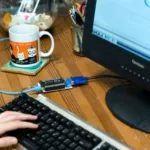Our finger tips are not only there for fingerprints, but are extremely sensitive sensory organs. We can feel wrinkles as small as 13 nanometers and our fingertips are essential for our everyday life, we use them for nearly everything we do with our hands. Researchers in South Korea have developed an electronic skin that could be the first step in giving robots tactile perception.
The researchers added a microstructure, similar to our fingerprint, to a ferroelectric film, noting that the microridge structure is essential in transferring and amplifying signals to receptors. The flexible structured e-skin can sense static and dynamic pressure, vibration, and temperature with high sensitivities. In a simulated situation it was capable of simultaneously monitoring a pulse and measuring the temperature of the veins.

A by-product of this newly developed e-skin is its ability to hear. In tests, the artificial membrane outperformed smartphone microphones in detecting acoustic sounds. The researchers used the e-skin and a smartphone to record the sound frequencies and patterns of a recording spelling out the word skin, and the e-skin did a better job.
Electronic skins have been in the making for a long time, with lots of challenges to make them applicable in real-world situations. They would have to stretch, heal, endure extreme changes in temperature, pressure and environment, be resistant to water and chemicals and they will need a constant source of energy. The microstructured ferroelectric skin mentioned here, has only been tested under lab conditions and has a long way to go before we see it in commercial use, but the idea and concept is promising. It could revolutionize robotic skins, giving machines the ability to detect small changes in pressure or heat, making them more aware of their environment and more capable of interacting with objects and humans. But I suppose the first applications will future wearable sensors and medical diagnostic devices.








